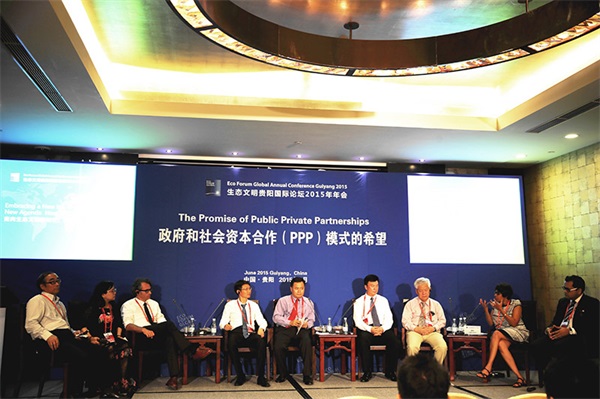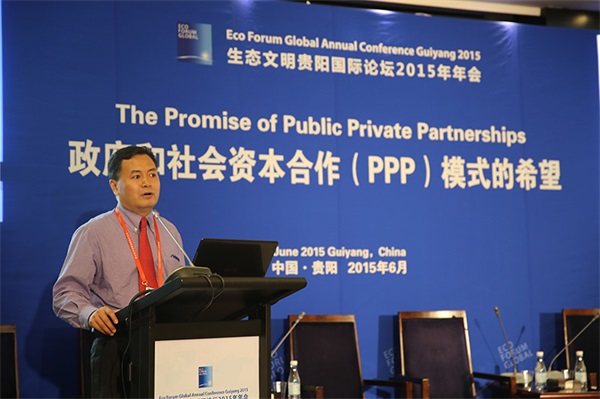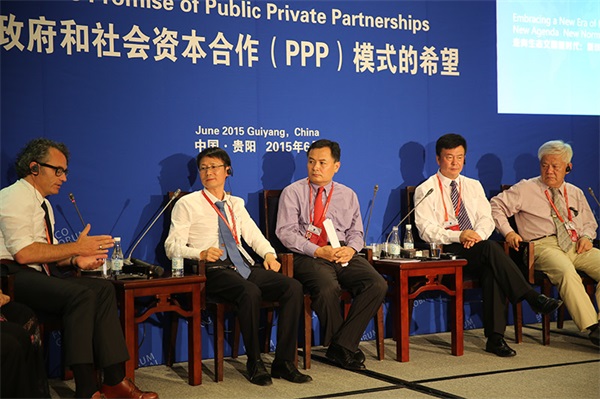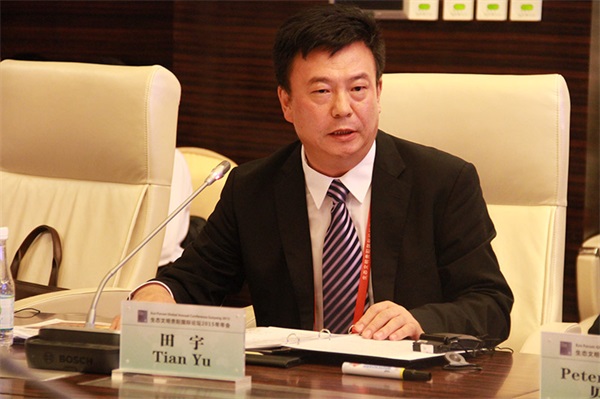Eco Forum Global Annual Conference Guiyang 2015: Overview of the Keynote Forum of “The Promise of Public-private Partnership
2015-06-27
Sponsored by the IISD and undertaken by the Guiyang Municipal People""s Government, the keynote forum was jointly held by the Guiyang Municipal Development and Reform Commission and China Water Environment Group (CWEG) - a professional water environment investment platform under CITIC Private Equity Funds Management Co., Ltd (CITICPE). Du Qinglin, a member of the Secretariat of CPC Central Committee and Vice Chairman of the 11th CPPCC National Committee, attended the opening ceremony and delivered a keynote speech. Dai Bingguo, former State Councilor of the Secretariat, and Zhang Huaixi, former Vice Chairman of the CPPCC also attended the opening ceremony. Zhao Kezhi, Secretary of the CPC Guizhou Provincial Committee and Director of the Standing Committee of the Guizhou Provincial People""s Congress, delivered an address. Speechmakers also included former Irish Prime Minister Bertie Ahern, former Pakistani Prime Minister Shaukat Aziz, the Swiss Federal Office for the Environment (FOEN)’s Director Bruno Oberle, former South Korean Unification Minister Yu Woo-ik, the Chinese Academy of Sciences (CAS)’s President Bai Chunli, Liu Cigui - Deputy Secretary of the CPC Hainan Provincial Committee and Governor, and Chen Miner - Deputy Secretary of the CPC Guizhou Provincial Committee and Governor. Zhang Xinsheng, Secretary General of the Eco Forum Global Annual Conference Guiyang, presided over the conference.
The conference was divided into three parts of keynote speech, audience questions and round-table discussion, during which Jiao Xiaoping, Deputy Director of the China PPP Center under the MOF, gave a speech entitled “Green Infrastructure and PPP”. He said, “after paying study visits to countries like Australia and Canada, we introduced the version 2.0 of PPP model in 2014, which considers PPP model not only as a means of financing but also as a tool promoting comprehensive reform of financing system and mechanism.” At present, the promotion of PPP model in China relies mainly on intelligent construction, institution building and demonstration project promoting. “The Guiyang Nanming River Water Environment Management Project serves as an example that basically fulfills the MOF’s strategy at that time,” added Jiao.

“To promote the PPP model, a series of policies have been issued by different ministries. Adopting the asset-heavy model of “finance + industry”, CITICPE has built four platforms focused on integrated urban water environment management, integrated urban solid waste disposal operations, integrated industrial environmental protection & management & operations, and integrated treatment of hazardous and industrial waste. Here are some examples. The first is the Nanming River Water Environment Management Project highly recognized by the MOHURD Minister Chen Zhenggao. Leaving professional fields to experts, the premium project yields quick returns and excellent results with low investment via systematic planning. The second is the Guang’an “Clean Water Action” Regional Water Environment Management Project which involves water supply, wastewater and sludge treatment, and watershed management for one city, two national-level parks and five counties. Complying with China’s “Ten Measures on Water”, the project sustainably supports 4.7 million people in Guang’an, ensures the safety of drinking water for 30 million residents in downstream Chongqing, and becomes an important ecological barrier for the Yangtze River watershed and the Three Gorges Reservoir Region. The last is the Shanghai Jiading Distict Underground WWTP approved as a demonstrator model by the MOF last year. In the upcoming 20 years, 350 million rural people in China are expected to move into cities, which will cause stress on urban living space and environmental capacity and then hinder urban development. CWEG’s underground WWTP, featuring “eco-friendliness, land intensiveness and resource utilization”, provides an effective solution to these problems and can eliminate odor and noise pollution. Above the ground, a flowing water park is built for recreational use. We eye this forum as an opportunity to engage the private sector actively in the course of China’s ecological civilization construction, so that the dream of building a beautiful China with a blue sky, lucid waters and lush mountains can be realized,” continued Tian Yu.
At the forum, keynote speakers explained the PPP model as a cooperative relationship between a government and a private investor from different perspectives, in which the two parties share both risks and profits, and implement PPP projects through integrating their available resources so that more people can enjoy high-quality public services. But how can the government give full play to its functions and optimize the financing in this relationship, and maximize the Value for Money on infrastructure procurement? CWEG Chairman Hou Feng, C.R.E.A.M. Europe PPP Alliance’s consultant Tillo Seeger, IDFC Project Equity Company Limited’s executive vice president, and other experts at home and abroad offered their advice.

Hou also expressed his opinions about how the government and enterprise should act in a PPP project and how to advance the progress. “First, the government should establish a good relationship with the enterprise and people. It is vitally important to fully mobilize the public since the PPP project is designed to provide Value-for-Money infrastructure and services for the public; second, developing the top-level system design provides the government with a technical guarantee for project reserve, assessment, supervision, pricing and service quality evaluation; third, as infrastructure and public services projects are linked to the government’s credibility and people’s livelihood, the enterprise must have strong investment and technical management capabilities, and should bear the most basic corporate social responsibility to build mutual trust with the government and people by offering high-quality services. Only in this way can a PPP project be well implemented.”
Kong Hainan, the Professor of School of Environmental Science and Engineering (ESE) at Shanghai Jiaotong University (SJTU), who had participated in the initial planning of the Nanming River project, was amazed by what the Nanming River looks like now. “Water pollution is a issue that develops in a very short time but takes a long time to eliminate at a very high cost. So when I re-visited the Nanming River two years later and found the river is no longer black and smelly, I felt very pleased though I missed the opening ceremony of the Eco Forum Global Annual Conference Guiyang this year. The Nanming River did not disappoint me,” said Kong Hainan, “I was deeply impressed by what a leader at the Guiyang Municipal People’s Government said, ‘Just do it in the way that you think is the best and adopt the solution that you think is the most viable’. Why could the Nanming River wash away the stigma of being black and smelly so quickly and become teemed with fish and shrimps again? The answer was a trust relationship built between the government and private partner.” Fan Yuansheng, Vice President of the China Association of Environmental Protection Industry (CAEPI), attributed the successful implementation of the Nanming River project to the government’s collaboration with a competent private partner with technical strengths.
At the night meeting themed on “Natural Capital Investment: New Momentum for Economic Growth”, CITICPE President Tian Yu delivered a wonderful speech. He pointed out that in the face of today""s pressing environmental issues, in order to achieve the goal of ecological civilization, it is necessary to reduce the “ecological deficit” and increase the “ecological surplus”. This entails guiding the private sector in increasing investment in natural capital, so as to provide a new driving force for China""s economic growth.

As a state-owned investment platform, CITICPE has long been focused on environmental protection, resource conservation and other fields related to natural capital. CITICPE is now the controlling shareholder of multiple specialized enterprises addressing specific areas, including integrated urban water environment management and operations, integrated urban solid waste disposal operations, integrated treatment of hazardous and industrial waste, integrated industrial environmental protection & management, and utility tunnel. Environmental protection has become an important channel for CITICPE to fulfill its corporate social responsibility and promote the construction of ecological civilization and sustainable economic development.
CITICPE has invested in aportfolio of projects in recent years, among which the Guiyang Nanming RiverWater Environment Management Project has been recognized as a demonstratormodel in China’s watershed management, the Guang’an “Clean Water Action” Regional Water Environment Management Project as a benchmark inChina’s regional water environment management, and theShanghai Jiading District Underground WWTP as an example in underground wastewatertreatment plant system.
In cooperation with local governmentsand financial institutions, CITICPE has helped improve significantly theefficiency of investment, construction, operation and financing throughconstantly exploring, applying and innovating project model, mechanism andtechnology. In the future, it will continue heavy investment in natural capitalto make environmental investment and resource utilization more efficient, andmeanwhile, offer advice on setting up natural capital investment industrialfunds relying on its rich experience in this regard.
Taking this forum and initiative as anopportunity, CITICPE will take the lead and mobilize the private sector toactively invest in natural capital, providing new driving forces for China’s economic growth through continuous innovation and learning.
 中国水环境集团
中国水环境集团









